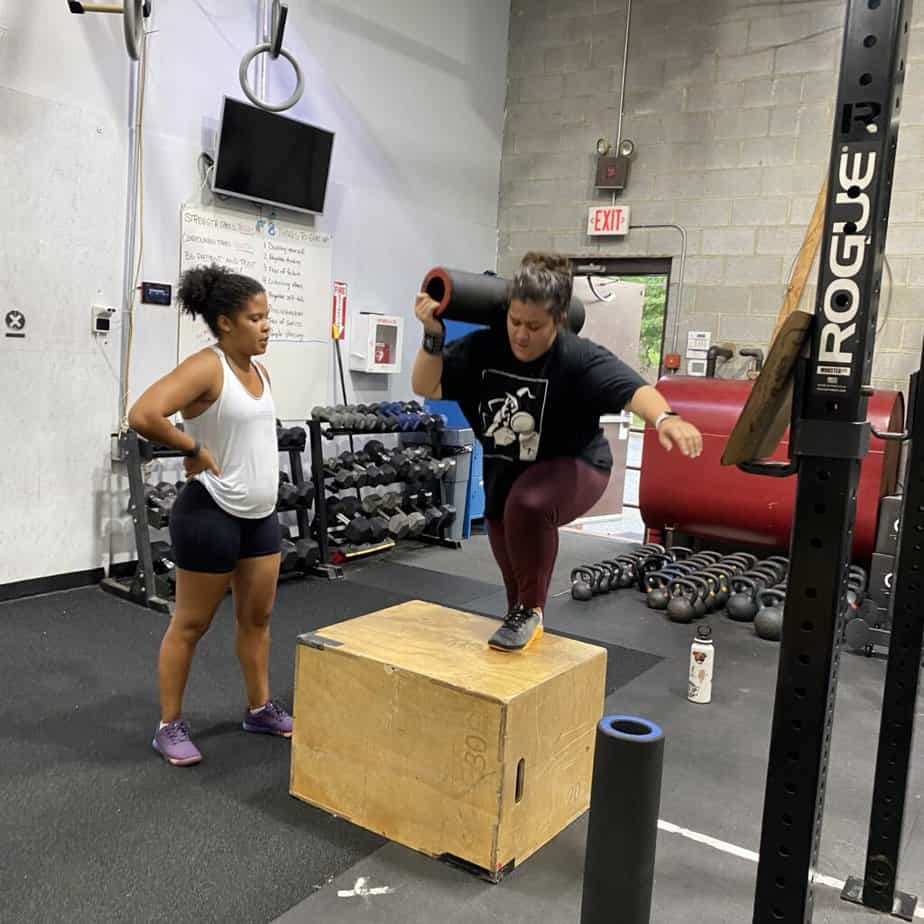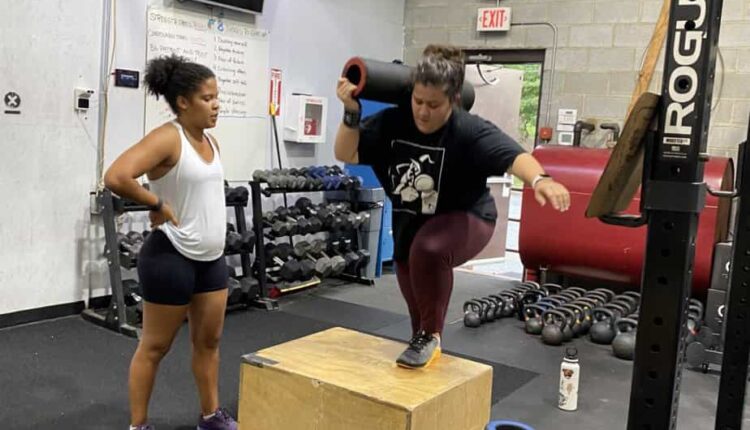CrossFit stands as a popular, yet challenging regimen. While it bolsters physical prowess, its demanding nature can make practitioners prone to injuries. This article presents an in-depth analysis of how integrating strength training into CrossFit routines can dramatically reduce these risks. Drawing upon scientific research and expert knowledge, we explore the critical role of strength in enhancing performance, mitigating injuries, and increasing resilience. This comprehensive guide offers practical advice and strategies for those seeking mastery in CrossFit, illuminating the connection between strength training and peak CrossFit performance. Uncover the crucial key to a safer, more effective CrossFit journey through the lens of strength training.


Key Takeaways
- Crossfit requires a blend of cardiovascular endurance, strength, flexibility, power, speed, coordination, and balance.
- Strength training is critical in mitigating the impact of Crossfit’s high-intensity workouts and reducing the risk of common injuries.
- Incorporating strength training into Crossfit routines improves body mechanics, strengthens stabilizer muscles, and progressively increases muscle growth and endurance.
- Proper nutrition, hydration, rest days, and listening to the body’s signals are crucial for injury prevention in CrossFit.
Understanding Crossfit and Its Physical Demands
In order to comprehend the core essence of Crossfit, one must first understand its inherent physical demands and the rigorous intensity it requires. Crossfit, as a high-intensity fitness regimen, demands a blend of cardiovascular endurance, strength, flexibility, power, speed, coordination, and balance. It incorporates varied functional movements performed at a high-intensity level, often within a competitive atmosphere. These activities are typically short, intense daily workouts that require maximum effort. They can include any combination of aerobic exercise, bodyweight exercises, and Olympic weightlifting. Consequently, the physical demands of Crossfit are high, necessitating not only physical strength but also mental grit and endurance. Understanding these demands is pivotal to mastering Crossfit effectively and safely.
The Importance of Strength Training
Building upon the inherent physical demands of Crossfit, it becomes apparent that strength training plays a pivotal role in ensuring safety and injury prevention during these rigorous routines. The development of musculoskeletal resilience through strength training is critical in mitigating the impact of Crossfit’s high-intensity workouts. It bolsters the body’s robustness, particularly the joints and connective tissues, reducing susceptibility to injury. Moreover, strength training enhances performance, fostering more efficient execution of complex movements integral to Crossfit. It fosters muscular endurance, power, and agility, critical elements in tackling CrossFit’s challenging workouts. Hence, integrating strength training into one’s CrossFit regimen not only builds physical prowess but also serves as a proactive measure in injury prevention, especially for aging adults.
Common Injuries in Crossfit
Several types of injuries are commonly associated with CrossFit, emphasizing the necessity for strength training as a protective measure. The most common injuries include rotator cuff tears, lower back strains, knee injuries, and Achilles tendinitis, often caused by the high-intensity, repetitive movements Crossfit demands. Improper form, inadequate rest, and lack of strength conditioning are key contributors to these injuries. Strength training, particularly in the core and stabilizer muscles, can significantly reduce these risks. It not only enhances overall performance but also improves body mechanics and efficiency, allowing for the safer execution of complex movements. Understanding these common injuries underscores the importance of incorporating strength training into CrossFit routines, reinforcing the need for athletes to educate themselves on injury prevention strategies.
How Strength Training Prevents Injuries
Strength training serves as a critical component in preventing Crossfit-related injuries by enhancing muscular endurance, improving body mechanics, and fortifying stabilizer muscles. By progressively increasing the load on your muscles, strength training promotes muscle growth and endurance. This adaptability allows athletes to endure the high-intensity nature of CrossFit workouts, reducing the risk of overuse injuries. Moreover, strength training improves body mechanics by enhancing body alignment and coordination, thus lowering the likelihood of injury caused by improper form. It also strengthens stabilizer muscles, the unsung heroes in maintaining joint stability and alignment, thereby preventing injuries related to instability. In essence, a well-structured strength training regimen can be the key to an injury-free CrossFit journey.
Key Strength Training Exercises for Crossfit
Incorporating a variety of five effective strength training exercises into your CrossFit routine can significantly boost muscular endurance and prevent injuries. These exercises include the deadlift, squat, bench press, overhead press, and pull-ups. Each of these exercises targets a unique combination of muscle groups, helping to develop comprehensive, balanced muscle strength.
| Exercise | Targeted Muscle Groups | Benefits |
|---|---|---|
| Deadlift | Lower back, glutes, hamstrings | Enhances stability, power and injury prevention |
| Squat | Quads, glutes, calves | Enhances stability, power, and injury prevention |
| Bench Press | Chest, triceps, shoulders | Improves balance, flexibility, and bone density |
| Overhead Press | Shoulders, triceps | Builds functional strength, enhances shoulder stability |
| Pull-ups | Back, biceps, shoulders | Boosts pull power, core stability |
Practicing these exercises regularly and with proper form can be instrumental in reaching your CrossFit goals while safeguarding against injury.
Proper Form and Technique in Strength Training
Understanding the significance of proper form and technique in strength training is essential for achieving optimal results and staying injury-free in your CrossFit journey. A meticulous approach to form and technique not only enhances performance but also mitigates the risk of injury. The key lies in mastering the fundamentals; precise alignment, controlled movements, and appropriate weight selection. This demands a keen awareness of your body and its limitations. Incorrect form can compromise the effectiveness of the exercise and lead to strain or injury. Therefore, it is crucial to learn and regularly practice correct techniques under the guidance of a qualified trainer. Remember, the goal is not merely to lift heavier or complete more reps, but to strengthen efficiently and safely.
The Role of Rest and Recovery
Equally important as mastering proper form and technique in strength training is acknowledging the role of rest and recovery in maintaining an injury-free CrossFit regimen. Ensuring your body has ample time to repair and rejuvenate itself between workouts is crucial in preventing overuse injuries, which are common in high-intensity fitness programs like CrossFit.
Here are five key aspects to consider for effective rest and recovery:
- Sleep: A minimum of 7-9 hours per night for optimal muscle recovery.
- Hydration: Replenishing fluids lost during workouts aids in muscle repair.
- Nutrition: Consuming a balanced diet to refuel energy stores.
- Active recovery: Light activities on rest days can promote blood circulation and muscle healing.
- Rest days: Including regular rest days in your workout schedule to allow full-body recovery.
Balancing proper nutrition plays a vital role in building strength and facilitating recovery, crucial components for maintaining an injury-free CrossFit routine. Optimal nutrition not only fuels workouts but also aids in muscle repair and growth.
To demonstrate the importance of nutrition, consider the following table:
| Nutrient | Function | Food Source |
|---|---|---|
| Protein | Muscle repair & growth | Chicken, fish, tofu |
| Carbohydrates | Energy supply | Rice, potatoes, whole grains |
| Fats | Hormone production & inflammation control | Avocados, nuts, seeds |
Understanding these fundamentals is a stepping stone towards mastering CrossFit training without succumbing to injuries. By prioritizing nutrition, athletes can ensure they are providing their bodies with the right tools for success, thus augmenting their CrossFit performance.
Sample Strength Training Program for Crossfit
An athlete’s strength training regimen serves as a fundamental component in crafting a sustainable, injury-free CrossFit routine. It offers the chance to build resilience and enhance performance while minimizing the risk of injuries.
Here’s a sample strength training program that can be integrated into a Crossfit routine:
- Deadlifts: A compound exercise that targets multiple muscle groups and enhances overall strength.
- Squats: This lower body exercise strengthens the leg muscles and improves balance and stability.
- Bench Press: A vital exercise for building upper body strength, primarily focusing on the chest muscles.
- Pull-ups: These work the back and arm muscles, promoting upper body strength and endurance.
- Overhead Press: This exercise targets the shoulder muscles and increases upper body power.
Each exercise should be performed with proper form to ensure safety and maximize efficiency.
Continual Progress: Updating Your Strength Training Routine
To ensure sustained progress and avoid plateaus in your CrossFit performance, it’s essential to regularly update your strength training routine, adapting to your evolving needs and capabilities. A stagnant routine can lead to decreased motivation and stalled progress, undermining your performance in CrossFit.
One effective approach is periodization, where you systematically vary your training intensity and volume. This not only promotes continual physical adaptation but also alleviates mental fatigue. Additionally, incorporating varied exercises that target different muscle groups can improve overall strength and balance, reducing injury risk.
Frequently Asked Questions
What Specific Gear or Equipment Is Necessary for Strength Training in CrossFit?
For strength training in CrossFit, essential gear includes a high-quality barbell, weight plates, kettlebells, dumbbells, a squat rack, and a bench. Protective equipment like wrist wraps, weightlifting shoes, and a weight belt are also beneficial.
How Do Individual Physical Conditions or Pre-Existing Injuries Influence the Approach to Strength Training?
Individual physical conditions or pre-existing injuries significantly influence the approach to CrossFit strength training, necessitating personalized regimens, modifications, and precautions to ensure safety and effectiveness while minimizing the risk of further injury.
What Are the Psychological Benefits of Integrating Strength Training Into a Crossfit Routine?
Integrating strength training into a CrossFit routine can enhance psychological benefits such as improved confidence, mental toughness, stress reduction, and mood enhancement, contributing to overall mental health and well-being.
Are There Alternative Training Methods That Can Be Used in Conjunction With Strength Training for Injury Prevention in CrossFit?
Yes, combining strength training with flexibility exercises, balance training, and proper nutrition can significantly enhance injury prevention in CrossFit. These methods collectively contribute to overall physical resilience and workout performance.
How Does the Frequency or Intensity of CrossFit Workouts Need to Be Adjusted During Periods of Strength Training?
To optimize CrossFit performance while strength training, it’s important to balance workout intensity and frequency. Lowering Crossfit intensity during heavy strength training periods prevents overexertion and promotes muscle recovery, thus reducing injury risk.
Conclusion
In summary, strength training plays a central role in enhancing CrossFit performance and mitigating injury risks. Incorporating specific strength exercises into CrossFit routines, coupled with sufficient rest, recovery, and proper nutrition, promotes overall physical resilience. Thus, for an efficient and safer CrossFit journey, an updated strength training regimen is crucial. This approach ensures a balanced fitness experience, fostering continual progress and an enhanced understanding of the interplay between strength training and optimum CrossFit performance.


Comments are closed.